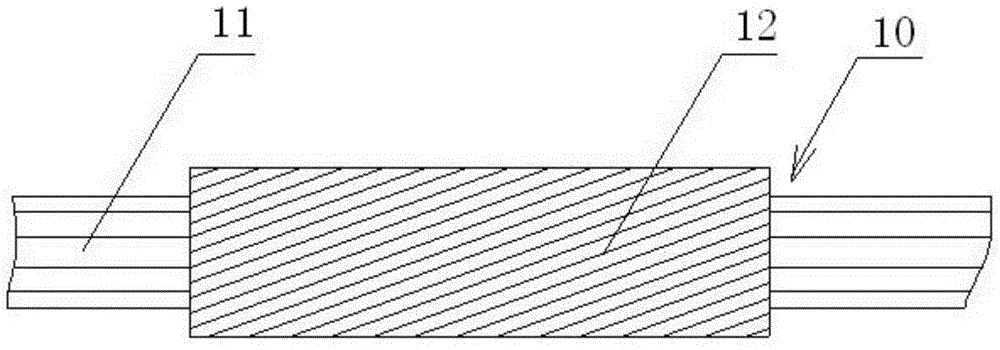Composite yarn for high-cutting-resisting-degree fabric
A cutting-resistant and high-grade technology, which is applied in the direction of yarn, textiles and papermaking, etc., can solve the problems of low fabric cutting resistance, high end-breakage rate, rough appearance of fabrics, etc., and achieve the effect of improving comfort and cutting resistance level
- Summary
- Abstract
- Description
- Claims
- Application Information
AI Technical Summary
Problems solved by technology
Method used
Image
Examples
Embodiment 1
[0022] Using 220dtex glass fiber filament as the core material and 50mm long para-aramid short fiber as the shell layer, the dust cage spinning process is used to spin 8.2Ne composite yarn, and the glass fiber content in the composite yarn is 31%. . The combination of this yarn and nylon spandex-covered yarn is used to knit gloves on a 13-needle machine with a double-layer weaving method. The cutting resistance test is carried out according to the ASTMF1790-05 standard.
Embodiment 2
[0024] in fineness Stainless steel fiber filaments are used as the core material, 50% of 50mm long para-aramid staple fibers and 50% of 50mmt long ultra-high molecular weight polyethylene fibers are used as shell layers, and dust cage spinning technology is used to spin 7.0Ne composite yarns. The content of stainless steel fiber in the composite yarn is 34%. The combination of this yarn and nylon spandex-covered yarn is used to knit gloves on a 13-needle machine with a double-layer weaving method. The cutting resistance test is carried out according to the ASTMF1790-05 standard.
Embodiment 3
[0026] Using 220dtex glass fiber filament as the core material and 50mm long para-aramid short fiber as the shell layer, the dust cage spinning process is used to spin 8.2Ne composite yarn, and the glass fiber content in the composite yarn is 31%. . The yarn is knitted on a 13-needle machine alone, and the cutting resistance test is carried out according to the ASTMF1790-05 standard. The test result is 3874 grams, which reaches the 5th grade of the American standard. Layer weave fabric.
PUM
| Property | Measurement | Unit |
|---|---|---|
| length | aaaaa | aaaaa |
| length | aaaaa | aaaaa |
Abstract
Description
Claims
Application Information
 Login to View More
Login to View More - R&D
- Intellectual Property
- Life Sciences
- Materials
- Tech Scout
- Unparalleled Data Quality
- Higher Quality Content
- 60% Fewer Hallucinations
Browse by: Latest US Patents, China's latest patents, Technical Efficacy Thesaurus, Application Domain, Technology Topic, Popular Technical Reports.
© 2025 PatSnap. All rights reserved.Legal|Privacy policy|Modern Slavery Act Transparency Statement|Sitemap|About US| Contact US: help@patsnap.com

